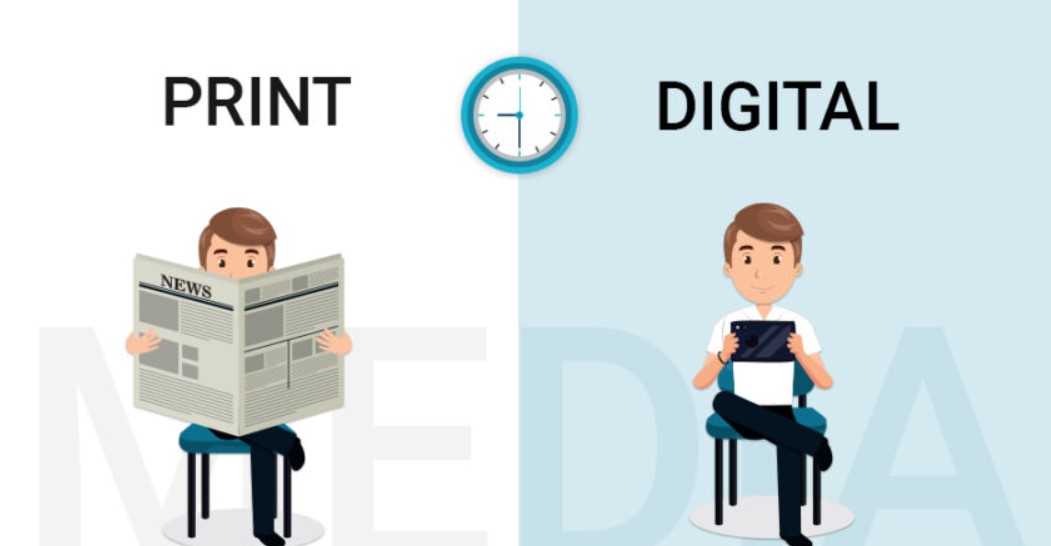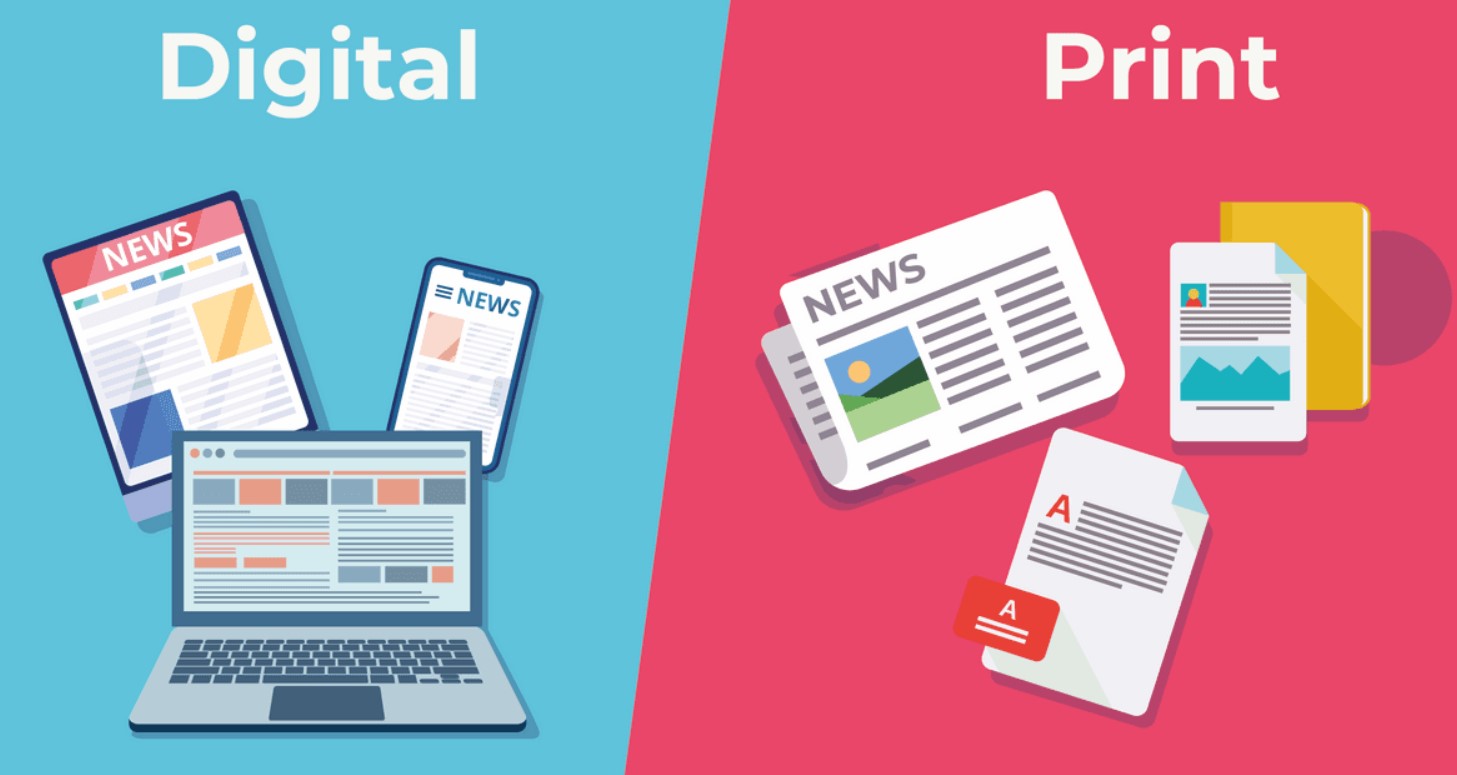Print vs. Digital Media: Which Is Superior?
In the age of technology, the debate between print and digital media has gained significant traction, with each medium having its own set of strengths and weaknesses. On one hand, print media, including newspapers, magazines, and books, offer a tangible and physical experience that many readers enjoy. The sensation of flipping through pages, the smell of fresh ink on paper, and the ability to underline or highlight passages contribute to the overall appeal and unique experience of print media. Additionally, print materials don’t require electronic devices or a reliable internet connection, making them accessible in almost any situation.
Conversely, digital media is fast, efficient, and easily accessible, making it a popular choice for the tech-savvy generation. E-books, online newspapers, blogs, and social media offer instantaneous updates and a wealth of information at our fingertips. With the ability to alter font sizes, use search functions, and store a multitude of reading materials in one device, digital media proves to be a convenient and portable choice. Moreover, digital media promotes interactive engagement through hyperlinks, comments, and shares, fostering a dynamic reading experience.
However, the superiority of one medium over the other largely depends on personal preference and context. For instance, a student may prefer an e-book for its searchability and portability, while a leisure reader may opt for a physical book for its tactile experience. Additionally, the impact on the environment cannot be overlooked. Digital media reduces the need for paper, thereby conserving trees and reducing pollution from paper manufacturing. Yet, the energy consumption and electronic waste generated from using digital devices pose their own environmental challenges.
In terms of advertising, print media can often be more expensive and has a limited reach compared to digital media. However, print ads are often regarded as more trustworthy and less intrusive, while digital ads can be targeted to specific audiences and tracked for effectiveness. In the world of journalism, print media is often associated with in-depth, thoughtful coverage, while digital media is known for breaking news and viral content.
Ultimately, both print and digital media have their unique advantages and challenges. The key is to understand their respective strengths and weaknesses, and to leverage them effectively in different contexts. It’s not about which medium is superior, but rather, it’s about how we can integrate both mediums to enhance our reading, learning, and communication experiences.
In conclusion, neither print nor digital media can be declared outright superior to the other. The choice between the two depends on various factors such as accessibility, convenience, personal preference, and the purpose of reading or viewing. As we continue to navigate the digital age, it is crucial to strive for a balance and synergy between print and digital media, leveraging the benefits of both to enrich our lives and societies.

Understanding Print Media
Print media remains a critical communication and information dissemination tool despite the rise of digital media. It encompasses various forms such as newspapers, magazines, brochures, and books. Understanding print media involves recognizing its strengths and limitations, as well as its impact on society. One of the key strengths is its ability to provide in-depth, detailed information about a specific topic. Moreover, it offers a tactile experience that digital media cannot replicate, contributing to a more immersive and engaging reading experience. However, print media also has limitations. It is not as timely as its digital counterpart, and its reach can be geographically limited.
In terms of societal impact, print media has played a significant role in shaping public opinion and influencing decision-making processes. It has been instrumental in providing a platform for diverse voices and perspectives, fostering a more informed and engaged citizenry. However, the content and presentation of information in print media can also be subject to bias, which can affect the public’s perception and understanding of issues.
Understanding print media also entails recognizing its economic and environmental implications. The production and distribution of print media require significant resources, contributing to environmental concerns. On the economic front, the print media industry has faced challenges due to the rise of digital media, leading to shifts in business models and strategies.
Moreover, the role of print media in advertising cannot be overlooked. It offers businesses a tangible way to reach their target audience, with the potential for greater engagement compared to digital advertising.
In conclusion, understanding print media is crucial in today’s information-driven society. It allows us to appreciate its value, navigate its challenges, and leverage its potential in various aspects of life.
Exploring Digital Media
In today’s ever-evolving technological era, exploring digital media has become an integral part of our daily lives. From social media platforms to online streaming services, the digital landscape has dramatically reshaped the way we communicate, consume content, and even conduct business. It is an exciting world of limitless possibilities where creativity, innovation, and knowledge converge and are shared instantly with people across the globe. Furthermore, digital media offers a unique platform for storytelling, allowing individuals and brands to engage with their audience in an immersive, interactive manner.
As we delve into the digital world, it is essential to understand its various facets. These include digital marketing, graphic design, video production, animation, amongst others. Each niche offers its unique set of tools and techniques, which can be harnessed to create compelling content that resonates with the target audience. For instance, digital marketing leverages social media, email marketing, and search engine optimization to enhance brand visibility and reach.
Moreover, exploring digital media also involves understanding the implications of our digital footprint. Every post, like, share, or comment we make contributes to our online persona, impacting how we are perceived by others. Therefore, it is vital to use digital media responsibly, ensuring that our online activities reflect our true selves and values.
As we continue to navigate the digital era, it is clear that digital media is not just a fleeting trend but a fundamental aspect of our contemporary society. It has transformed traditional media, offering a more accessible, inclusive, and dynamic platform for information dissemination. Therefore, learning and understanding digital media is no longer an option but a necessity for everyone, regardless of age or profession. It is our passport to the world, enabling us to connect, communicate, and collaborate like never before. Therefore, let us embrace the digital revolution and harness its full potential to create, inspire, and make a positive impact on the world.
The Print vs. Digital Media Debate
The Print vs. Digital Media Debate continues to be a compelling discourse in today’s fast-paced, technology-driven world. Traditional print media, such as newspapers, magazines, and books, have been around for centuries, holding a deep-rooted place in society. They offer a tangible reading experience and are often associated with credibility, thoroughness, and in-depth analysis. However, the advent of the digital age has significantly challenged the prominence of print media.
Digital media platforms, including websites, blogs, and social media, provide a plethora of content at an unprecedented pace, allowing immediate access to information from anywhere around the globe. This immediacy, coupled with the potential for interactive and multimedia content, makes digital media an attractive proposition for many, particularly the younger generation. Yet, it’s not without its drawbacks. Concerns about the veracity of digital content, cyber-security issues, and the impact on mental health due to excessive screen time are notable. Additionally, the ‘digital divide’—the gap between those who have access to digital technology and those who don’t—also comes into play, questioning the universal accessibility of digital media.
On the other hand, the environmental impact of print media production and distribution can’t be overlooked. Thus, the Print vs. Digital Media Debate is multifaceted, involving considerations of access, cost, credibility, environmental impact, and personal preference. While some argue that digital media will eventually replace print, others believe that both can coexist, each serving different needs and preferences. In the end, the shift from print to digital or the balance between the two will likely be dictated by evolving consumer behavior, technological advancements, and societal changes.
Print Media Overview
Print media, a traditional form of communication, has been a cornerstone of society for centuries. It comprises various formats such as newspapers, magazines, brochures, newsletters, books, and journals. These mediums are known for their wide reach and long-standing credibility. Their influence extends to both broad and niche audiences, owing to their diverse range of topics and genres. Print media contributes significantly to information dissemination, education, and entertainment.
The evolution of print media has been remarkable. From the invention of the printing press in the 15th century to the modern digital printing technologies, print media has continuously adapted to the changing times and consumer behaviors. Despite the advent of digital media, print media has retained its significance due to its tangible nature and perceived authenticity. It remains a preferred choice for many readers who value the tactile experience of flipping through pages, highlighting important information, and retaining knowledge through physical interaction.
Print media also plays an integral role in advertising and marketing. It offers businesses a platform to reach potential customers, promote their products or services, and build their brand image. The non-intrusive nature of print advertisements, coupled with the high level of attention readers give to printed content, often leads to better ad recall and response rates.
However, the print media landscape is not without its challenges. The rise of digital media poses a significant threat, with many consumers preferring to consume news and entertainment online due to convenience and speed. Additionally, environmental concerns over paper usage and waste have raised questions about the sustainability of print media.
Despite these challenges, print media continues to hold a distinct position in the global communication landscape. It remains a reliable source of information and continues to command respect for its in-depth reporting, thoughtful analysis, and creative expression. Its resilience and adaptability will likely ensure its survival and relevance in the coming years.

Digital Media Overview
Digital media is a broad term that encompasses multiple channels of communication and information dissemination, powered by digital technologies. It includes all forms of electronically produced content such as websites, social media platforms, audio and video content, digital art, online games, virtual reality experiences, and other interactive media. These media channels have revolutionized the way we communicate, interact, learn, and entertain ourselves in modern times. From the perspective of businesses, digital media provides a platform for advertising, marketing, and customer engagement. Many companies are taking advantage of digital media to broaden their reach, increase brand visibility, and gain insights into customer behaviour.
On the other hand, consumers use digital media for various purposes such as social interaction, entertainment, research, education, and purchases. The explosion of smartphones and internet connectivity has made digital media accessible to a vast population around the world. Digital media platforms such as Facebook, YouTube, Instagram, and Twitter have millions of active users daily, reflecting the widespread influence of digital media on our lives.
However, the pervasive nature of digital media also raises concerns about privacy, security, and misinformation. The digital footprint left by users and the vast amount of personal data shared online poses significant challenges in terms of data protection and privacy. Additionally, the spread of false or misleading information through digital media platforms is a substantial societal concern.
Despite these challenges, the power of digital media to connect people, share information, and create virtual communities is undeniable. It has transformed the way we live and work, providing opportunities for creativity, innovation, and global connection. As technology continues to evolve, so too will the landscape of digital media, offering new avenues for communication and interaction in the digital age.
Promoting Your Media with Strikingly
Strikingly is an innovative platform that enables users to create stunning websites with ease, making it an excellent tool for promoting your media. Utilizing Strikingly’s features can significantly enhance your online presence, allowing you to reach a broader audience with your content. Whether you’re a blogger, a photographer, a musician, or a filmmaker, Strikingly’s customizable templates can cater to your unique needs and style.
With its user-friendly interface, you can effortlessly upload your media, from articles and photos to music and videos, and present them in an aesthetically pleasing way. Strikingly also has built-in SEO tools to improve your website’s visibility on search engines, which is crucial for drawing more traffic to your site. It also supports social media integration, enabling you to connect your website to your social media accounts and vice versa, thereby increasing your engagement with your audience. Furthermore, Strikingly offers analytics features, allowing you to monitor your website’s performance and gain insights into your visitors’ behavior.
This data can guide you in refining your content and marketing strategy to boost your media’s appeal and reach. Thus, Strikingly can be your powerful ally in promoting your media, providing you with the resources to establish a compelling online presence and connect with your audience more effectively. With Strikingly, you are not just building a website, but creating a dynamic platform where your media can shine and resonate with your audience.

Final Thoughts
Final thoughts serve as a concluding analysis or reflection on a particular topic, subject or event. They encapsulate the essence of the discussions, experiences or debates undergone thus far and provide a summary or a personal perspective on the matter. Final thoughts are like the concluding notes in a symphony, they tie together all the individual threads of the discourse, giving it a sense of completion and closure. They are crucial as they leave a lasting impression and can often provoke further thought or action.
They may also be an opportunity for the individual to express their emotions, sentiments, and recommendations, providing a deeper insight into their viewpoint. The power of final thoughts lies in their ability to influence the listener or reader’s perception, thereby making them an important tool in communication. In academic or professional settings, final thoughts are often used to summarize the key points, propose future directions, or highlight the implications of the discussion. In more personal contexts, final thoughts could be reflections on one’s experiences or lessons learned.
Regardless of the context, final thoughts are a critical component of any discourse, serving as the concluding chapter that brings closure and leaves a lasting mark. They are not merely a summary but are often a synthesis of ideas and experiences, providing a holistic view of the subject matter.
